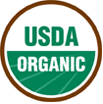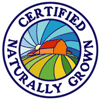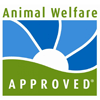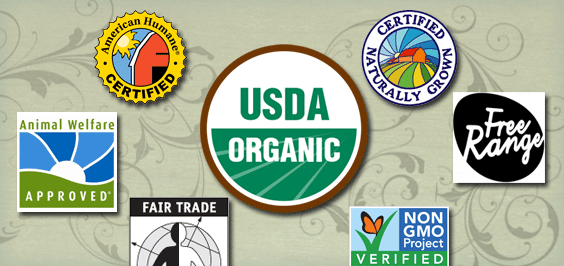Another trip to the grocery store? Why? Well, mainly because it’s where so much of what we eat comes from, regardless of where it was originally grown. A few months ago, when I was looking into how much of the food at the grocery store was genetically-engineered, I became very familiar with investigating all those packages. Sometimes I needed a magnifying glass, while other times nutritional claims were plastered in huge letters across the front of the box.
Labels and logos can make life easier and act as a shortcut to knowing more about a product, but they can be confusing if you don’t know what they all mean. I’ve arrived in my mother’s kitchen to hear the question, “Are these the right kind of eggs to buy?” more than once. Cage-free, free-range, organic, omega-3 enhanced, all natural — I’m feeling dizzy already.
So let’s start by seeing what labels are on those grocery store shelves.
Organic
 First up is “organic,” a term that’s been around since 1940 to describe farming practices. More recently, the USDA officially defined organic and came up with the National Organic Program and this snazzy seal to show that the product has been certified organic. This label can be used on fruits and vegetables, dairy, meat, processed foods, beverages and even health and beauty items. What’s it mean? That these items contain at least 95% organic ingredients with no synthetic growth hormones, antibiotics, pesticides, biotechnology, synthetic ingredients or irradiation used in production or processing. If products contain at least 70% organic ingredients, they can be marketed as “made with organic ingredients.”
First up is “organic,” a term that’s been around since 1940 to describe farming practices. More recently, the USDA officially defined organic and came up with the National Organic Program and this snazzy seal to show that the product has been certified organic. This label can be used on fruits and vegetables, dairy, meat, processed foods, beverages and even health and beauty items. What’s it mean? That these items contain at least 95% organic ingredients with no synthetic growth hormones, antibiotics, pesticides, biotechnology, synthetic ingredients or irradiation used in production or processing. If products contain at least 70% organic ingredients, they can be marketed as “made with organic ingredients.”
One trick I use all the time at the store is looking at the PLU code on the sticker of loose bulk produce at the store (the big bins of apples, oranges and everything else). All organic produce starts with the number 9, while conventional produce starts with the number 4. Sometimes the apple goes wandering from its original spot or is mis-labeled by the store, but with this tip, you can take a quick peek at the sticker to see whether your Granny Smith is organic or not.
Certified Naturally Grown
 This label denotes the food was grown using the same standards as those for organic, but not on a farm actually certified by the National Organic Program of the USDA. Some farmers have criticized the cost and process they need to go through to participate in the USDA’s organic program, so this is an alternative, non-governmental certification system where other farmers act as inspectors in a program administered by a non-profit organization called Certified Naturally Grown. “Natural” is a term you see a lot on food products (some of which you’d hardly call natural at all), so look closely at the label. The Certified Naturally Grown label indicates that someone is certifying it is indeed natural, rather than just the label “Natural” as marketing bluster.
This label denotes the food was grown using the same standards as those for organic, but not on a farm actually certified by the National Organic Program of the USDA. Some farmers have criticized the cost and process they need to go through to participate in the USDA’s organic program, so this is an alternative, non-governmental certification system where other farmers act as inspectors in a program administered by a non-profit organization called Certified Naturally Grown. “Natural” is a term you see a lot on food products (some of which you’d hardly call natural at all), so look closely at the label. The Certified Naturally Grown label indicates that someone is certifying it is indeed natural, rather than just the label “Natural” as marketing bluster.
Fair Trade
 Another label that shows up often at grocery stores, coffee shops and elsewhere is “fair trade certified.” This label shows up on many brands of coffee, but it’s used on other products too, like bananas, tea, cocoa and sugar. Unlike organic, fair trade isn’t certified by the government. Instead, it’s enforced worldwide by the Fairtrade Labelling Organizations International (FLO) and in the U.S. by Fair Trade USA. Fair trade products must be produced in accordance with the following guidelines: Workers must receive decent wages, housing, health and safety guidelines, the right to join trade unions and child or forced labor is completely prohibited. Crops must also be grown, produced and processed in a manner that supports social, economic and environmental development.
Another label that shows up often at grocery stores, coffee shops and elsewhere is “fair trade certified.” This label shows up on many brands of coffee, but it’s used on other products too, like bananas, tea, cocoa and sugar. Unlike organic, fair trade isn’t certified by the government. Instead, it’s enforced worldwide by the Fairtrade Labelling Organizations International (FLO) and in the U.S. by Fair Trade USA. Fair trade products must be produced in accordance with the following guidelines: Workers must receive decent wages, housing, health and safety guidelines, the right to join trade unions and child or forced labor is completely prohibited. Crops must also be grown, produced and processed in a manner that supports social, economic and environmental development.
Animal Welfare Approved/American Humane Certified

 These two programs are completely separate and run by different non-profit organizations, but they both have similar goals: to certify that animals are raised in a humane manner. For more details on these two programs, see our Food Label Fact Sheet.
These two programs are completely separate and run by different non-profit organizations, but they both have similar goals: to certify that animals are raised in a humane manner. For more details on these two programs, see our Food Label Fact Sheet.
The labels I mentioned above are all certified or tested by third parties.
The ones below are claims that producers and processors make, but aren’t independently verified.
GE-Free / Non-GMO
 OK, I just said none of these are third-party certified, but there is one exception with labels that claim to be free of genetically engineered (or GE or GMO) ingredients. The Non-GMO Project is a non-profit organization that verifies products are produced according to their standards for avoiding GMO ingredients. Otherwise, some companies and producers do claim that they are GE-free, but you’ll need to rely on the honor system.
OK, I just said none of these are third-party certified, but there is one exception with labels that claim to be free of genetically engineered (or GE or GMO) ingredients. The Non-GMO Project is a non-profit organization that verifies products are produced according to their standards for avoiding GMO ingredients. Otherwise, some companies and producers do claim that they are GE-free, but you’ll need to rely on the honor system.
Raised Without Antibiotics
Chickens, pigs, and cattle raised on industrial farms are routinely fed low doses of antibiotics (the same drugs we rely on to keep ourselves and our families in good health) to make them grow faster and compensate for overcrowding and unsanitary living conditions. This label states the meat or dairy was raised without the use of antibiotics.
Hormone-Free / rBGH-Free
This one you see mostly in the dairy aisle — it means that the farmer has chosen not to inject his or her cows with the artificial growth hormone called rBGH. It’s also used on beef and chicken products, where the animal was raised without growth hormones or steroids. However, the USDA prohibits giving hormones to chickens, so the label doesn’t mean much there — all chicken you buy will be hormone-free whether it’s labeled or not. And organic milk is always from cows raised without artificial growth hormones.
All about eggs: Organic / Free-range / Cage-free / Omega-3 / etc.
I can’t think of any grocery store product out there that has as many different labels and claims on them as eggs. What do they all mean? The USDA does have standards for what organic chicken eggs are, but the other terms are less defined.
- Organic eggs can only come from chickens that eat certified organic feed, they must have access to the outdoors and can’t be raised in cages.
- Free-range poultry is defined as birds that spend part of their time outside (whether that’s 10 minutes per month or 10 hours per day) and don’t live in cages. However, the USDA doesn’t have a legal definition of free-range chicken eggs.
- Cage-free birds are un-caged, but generally spend their time indoors.
- Those claims about Omega-3 fatty acids you may have seen on eggs recently? Eggs naturally have omega-3 fatty acids, which have some evidence of health benefits, but to increase the amount of these, some chickens are fed a special diet that may include fish oils, canola oil or flax oil.
The Non-Label Labels
And finally, some labels out that there are vague and often don’t mean a whole lot. These ones aren’t defined, certified or tested by a third party, so if you want more information, you’ll have to track down the individual company or producer. My un-favorite of these? “All natural!” Sure, it sounds great, but it has no official definition or standard in the U.S., so it effectively means nothing. Some “natural” products you’ll find probably really are minimally-processed foods from ingredients you’d recognize and could make yourself. For other ones, you’ll need access to a laboratory and some scary chemicals. Go ahead and buy these if you like, but you’ll want to investigate if you want more information because the label won’t tell you anything.
Looking around the grocery store, for processed foods (most of those aisles) health claims and “all natural” messages are by far the most common I came across. They’re vague or misleading enough to not tell me anything. For fruits and vegetables, it’s a bit easier as there are usually only a couple labels to look for (organic or maybe Fair Trade Certified). Meat, dairy and eggs is where more labels come into play. Seeking out the labels above, can offer a broad idea of what I’m getting without having to comb through the fine print on the back of a box or drive out to the farm to check up on exactly how those eggs got into that pretty carton.
Further Reading
- If you’ve ever wondered why it seems so hard to find meat raised the way you want, you’ll want to take a look at this month’s Ask Farm Aid. It looks into the the powerful corporate players that dictate every detail of how livestock are raised and meat is produced.
- Read our Farmer Hero profile of Jason Schmidt, a fifth generation Kansas farmer who raises grass-fed cattle and says, “There is a lot of personal satisfaction from knowing you are producing very healthy products and being a better environmental steward.”
Next
Jason Schmidt


